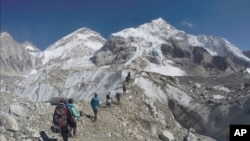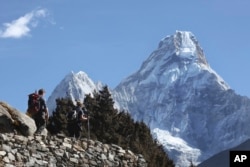Climbing Mount Everest, at 8,848 meters the tallest mountain in the world, has long been the ultimate challenge for people with something to prove. Two of the most recent teams making a bid for the summit learned how the lonely task of climbing a mountain can bring you closer to other people.
On May 24, retired U.S. Army Staff Sergeant Chad Jukes, 32, became the second combat wounded veteran to get to the summit of Mount Everest, climbing with an artificial leg to replace the limb he lost to an improvised explosive device in Iraq in 2006.
The first was U.S. Marine amputee Charlie Linville, wounded in Afghanistan in 2011, who summited just days earlier.
Jukes, an accomplished climber, was accompanied by two active duty Army officers - 2nd Lt. Harold Earls and Capt. Elyse Ping Medvigy. The trio made their climb in order to bring awareness to post-traumatic stress disorder and the high suicide rate among returning U.S. veterans.
For many veterans, including Jukes, the suicide problem hits close to home. One of the organizers, retired Command Sgt. Maj. Todd Burnett, told Hashtag VOA Tuesday that one of Jukes' Army buddies committed suicide while Jukes was away on the climb.
"There's 22 veterans taking their lives a day," Burnett said. "So we wanted to show the resilience of the climb, and the comradery."
Resilience
Burnett said the team -- known as USX, for the nonprofit U.S. Expeditions and Explorations, completed their descent of the mountain on May 29. "Chad had some frostbite on his hands, Harold had some on his feet, but overall they're in good physical condition," he said.
Burnett said the point of the climb was not to echo the experience of combat, because nothing could do that, but to give the climbers "a life changing experience, just the way combat is. It gives you... people you will have a lifelong bond with. So in the middle of the night, if you're having a problem and you can't cope, you reach out to that person and that person will help you."
Burnett said war veterans give more of themselves in combat than anyone could understand, and he wants to help keep them alive once they come home. He said, "That's what we're trying to do: just raise awareness, show that you can overcome things, and that there's people you can lean on."
The USX team is sharing its expedition the old-fashioned way -- through telling the stories now that the trip is at an end. Adventure guides Cory Richards and Adrian Ballinger carried an extra seven kilograms of equipment up the world's highest peak to share their adventure in progress -- through the mobile app Snapchat.
Snapshots from the top of the world
On Snapchat, Richards told VOA's Andrew Palczewski of Hashtag VOA Tuesday, "You can't alter anything, and you've got a limited amount of time to say something and you just say it, you show it, and you move forward." He said the mobile app gives a "much more raw, unfiltered look" at the climb than traditional media can do.
The app allows the user to post short sound-and-image "snaps" that are accessible for a limited time and then disappear.
Because there is no regular cellular service on the world's highest peak, transmissions took 10 to 15 minutes, so they were accomplished mainly during the climbers' down time. Richards tried to snap an image from the summit itself when he reached it on May 24, but his phone died in the "thin air" -- meaning low oxygen -- at the peak. Because the altitude is as dangerous for humans as it is for cellphones, Richards spent only three minutes at the summit.
But the view from the peak wasn't the most important part of the climbers' message to their followers, Ballinger said. The view they wanted their followers to see was the weeks of work -- including the boring, frustrating and mundane moments -- that lead to one big moment of glory.
VOA's Andrew Palczewski contributed to this report










